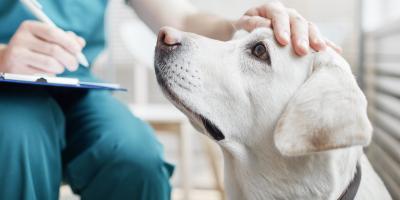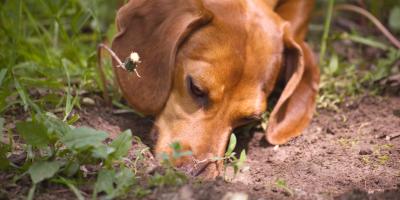Alopecia in Dogs: Why is Your Dog Losing Hair?


Alopecia in dogs can seem startling. In addition to health concerns you may have, losing patches of hair changes the appearance of their coat. For long-hair breeds in particular, this may look worrisome.
The good news is, in many cases, dog hair loss is treatable. Just make sure to talk to your veterinarian about what is causing hair loss in your dog. The reasons can vary widely, but losing fur is often a sign your pet needs medical attention.
If you’re wondering, Can dogs get alopecia?, read on to learn about the causes, symptoms and treatment options for hair loss in dogs.
What is Alopecia in Dogs?
Alopecia in dogs is the partial or complete loss of fur on your canine companion’s body. It’s often triggered by a skin condition such as allergies, but can also be associated with other immune, endocrine and lymphatic disorders.
Alopecia isn’t the same as shedding. The latter happens as part of your dog’s cycle of naturally removing old or dead fur, while alopecia occurs as a result of damage to the hair follicle.
Why is Your Dog Losing Hair?
If your dog has alopecia, it could be caused by a variety of reasons:
Mange
Mange in dogs is a skin disease caused by parasitic mites. There are two types – Demodectic and Sarcoptic mange – and both are associated with hair loss.
Skin Allergies
Dermatitis (also known as skin allergies) can cause itching, scratching and inflammation, leading to a loss of fur.
Fleas
For many dogs, saliva from a flea bite creates an overreaction from their immune system, causing intense itchiness. Flea bites can make your dog feel itchy all over their body, sending them into a scratching frenzy and damaging their skin as a result.
Rash
A dog rash is characterized by irritated skin. Depending on where it develops on your pet’s body, it might trigger hair loss.
Ringworm
Ringworm is a contagious fungal infection. Typically, it affects areas like the face, tail, tips of the ears, bellies and paws. Dogs with weakened immune systems, puppies and senior canines are at increased risk.
Hypothyroidism
Hair loss in dogs with no itching may be related to a hormonal skin disease such as hypothyroidism. In addition to alopecia, symptoms can include lethargy and weight gain. Other hormonal diseases like Cushing’s Syndrome can also result in hair loss.
Trauma
Incidents such as burns can damage or destroy your dog’s hair follicles.
Genetics
Alopecia can also be inherited from a pet’s mother or father.
Poor Nutrition
Diet contributes to the health of your dog’s coat. If your pet isn’t eating nutritious dog food, their fur may start to suffer and fall out.
Seasonal Alopecia in Dogs
For some dogs, seasonal alopecia occurs once per year, usually in the autumn and winter months. It usually happens along their flank.
The exact cause of seasonal hair loss is unknown. However, it’s likely related to an abnormal response of your pet’s hair follicles to hormonal changes that happen as a result of shorter days. Often, the hair grows back between seasons.
Boxers, Schnauzers and English Bulldogs tend to be affected by seasonal alopecia more than other breeds.
Symptoms of Alopecia in Dogs
Alopecia in dogs is characterized by hair loss and bald patches. Because it can be related to different conditions, however, look for other symptoms to help you narrow down potential causes.
Here are some additional signs to watch for:
- Dandruff
- Dry skin or oily coat
- Crusting or inflammation
- Itchiness
- Scaling
- Dark patches of skin
- Pimples or bumps
Can All Dogs Get Alopecia?
Dog alopecia can affect all breeds, but there are some who tend to experience it more than others:
- Bulldogs
- Dobermans
- Yorkshire Terriers
- Dachshunds
- Retrievers
- Xoloitzcuintli
Diagnosing Hair Loss in Dogs
If your dog is losing fur, take them to the veterinarian. In addition to a general health screening, they’ll evaluate the health of the skin and coat. Checking for fleas, ticks and mites is also likely.
It’s possible your veterinarian will conduct a skin scraping or other test. This can help them identify the presence of a bacterial, fungal or yeast infection.
A blood sample may also happen if they suspect alopecia is caused by a hormonal problem or another underlying disease.
If allergies seem to be driving hair loss, your veterinarian will try to pinpoint the cause and recommend appropriate treatment.
Dog Alopecia Treatment
Treatment for dog alopecia will depend on the reason for the hair loss. Again, there could be a number of causes, so getting a formal diagnosis from your veterinarian is key.
Skin allergies may require topical therapy, which can include hypoallergenic or medicated shampoos, as well as ointments. If appropriate, antihistamines might be recommended. These can all help eliminate or reduce skin inflammation and itching that leads to loss of fur.
For skin conditions, your veterinarian may also recommend switching to complete and balanced dog food, depending on your pet’s current diet. Dog food for sensitive skin is also an option.
If hair loss is due to a fungal infection, antifungal shampoos and oral medications may help eliminate the infection and return the skin and coat to its normal, healthy state.
When caused by a skin condition, alopecia typically clears up relatively quickly with treatment.
If hormonal conditions like an underactive thyroid are to blame, they will likely require longer-term care. Importantly, though, alopecia will often reverse with treatment.
Dog hair loss is an unfortunate condition that’s often related to skin disorders, infections, hormonal diseases and genetics. With a treatment plan from your veterinarian, though, your canine companion can likely regrow their hair and restore their health.
Want more care tips? Check out our other dog health articles for advice from our experts.
Related articles

Reward Yourself with myPurina
Earn and redeem rewards for Purina products with the myPurina app.






